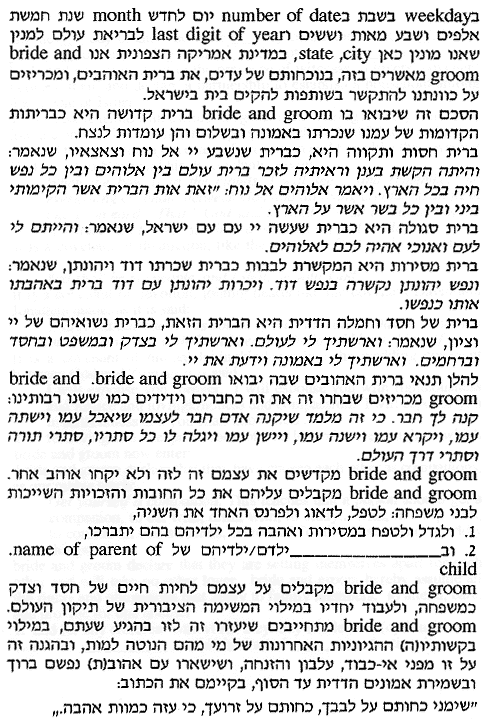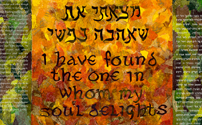- Traditional Texts
- Traditional Egalitarian Texts
- Modern Texts
- Covenant Texts
- Interfaith Texts
- Same Gender Texts
- Secular Texts
Covenant Texts
Brit Ahuvim/Lovers' Covenant
The B’rit Ahuvim or Lovers’ Covenant was written by Rachel Adler in Modern Hebrew for her own wedding and published and thoroughly explained in her book, Engendering Judaism (Beacon Press, 1998). Adler is a Jewish feminist theology professor at Hebrew Union College in Los Angeles, California. This text, which she describes as “a new legal model for right relations between husbands and wives”, draws upon the halakha of Jewish partnership law for creating a Jewish marriage. In this it is revolutionary.
The B’rit Ahuvim or Lovers’ Covenant text creates an egalitarian partnership for the marrying couple which is formed by mutual agreement. Adler includes grammatical provisions to allow her text to be easily used for same-gender marriages. Partnership law is the basis for this text and the marriage it creates. The marriage created is not a halachic Jewish marriage but rather a halchic Jewish partnership. Adler describes the rituals that should establish this marriage (see pp. 195-8). The most innovative ritual is an ancient version of kinyan. In this, the partners acquire the partnership by placing symbols of pooled resources (often including wedding rings) into a bag, lifting it together, and reciting a blessing. This form of kinyan was used in ancient times exclusively for creating partnerships under Jewish law. While Adler encourages couples to write their own, several intentions for the marriage are included in the text. The partners agree to pool their resources and to make joint decisions about their distribution; to base their marriage upon monogamy, tikkun olam and other Jewish communal responsibilities; to care and provide for each other and for any children; and to help each other at the time of dying. The B’rit Ahuvim connects the marrying couple to God, Israel and Jewish history by quoting several definitions and instances of covenant found throughout theTanakh.
The B’rit Ahuvim or Lovers’ Covenant can be dissolved as a partnership would be dissolved. Either partner may initiate a divorce. The divorce should be conducted by a Beit Din (a court of three learned Jews). At the dissolution proceeding, the court should draw up a document in Hebrew (and translate it into the vernacular) that attests to the termination of the covenant, the distribution of property, and any continuing obligations. This document should be signed by two witnesses. Adler suggests that the divorce be held in public rather than in a Rabbi’s study with only the court and witnesses present. Religious community, friends and family should be present to comfort and console the two partners and to acknowledge that a covenant has failed.
English:
On the day of the week, the day of the month of , in the year , corresponding to the day of , , here in , bride and groom confirm in the presence of witnesses a lovers’ covenant between them and declare a partnership to establish a household among the people of Israel.
This agreement into which bride and groom are entering is a holy convenant like the ancient covenants of our people, made in faithfulness and peace to stand forever. It is a covenant of protection and hope like the covenant God swore to Noah and his descendants, saying,
When the bow is in the clouds, I will see it and remember the everlasting covenant between God and all living creatures, all flesh that is on earth. That,” God said to Noah, “shall be the sign of the covenant that I have established between me and all flesh.
It is a covenant of distinction, like the covenant God made with Israel, saying You shall be my people, and I shall be your God.
It is a covenant of devotion, joining hearts like the covenant David and Jonathan made, as it is said:
And Jonathan’s soul was bound up with the soul of David. Jonathan made a covenant with David because he loved him as himself.
It is a covenant of mutual lovingkindness like the wedding covenant between God and Zion, as it is said,
I will espouse you forever. I will espouse you with righteousness and justice and lovingkindness and compassion. I will espouse you in faithfulness and you shall know God .
The following are the provisions of the lovers’ covenant into which bride and groom now enter:
bride and groom declare that they have chosen each other as companions, as our rabbis teach:
Get yourself a companion. This teaches that a person should get a companion, to eat with, drink with, to study… with, to sleep with, to confide all one’s secrets, secrets of Torah and secrets of worldly things.
bride and groom declare that they are setting themselves apart for each other and will take no other lover. bride and groom hereby assume all the rights and obligations that apply to family members: to attend, care, and provide for one another
- and for any children with which they may be blessed. (optional)
- and for , child/children of. (optional)
bride and groom commit themselves to a life of kindness and righteousness as a Jewish family and to work together toward the communal task of mending the world. bride and groom pledge that one will help the other at the time of dying, by carrying out the last rational requests of the dying partner, protecting each other from indignity or abandonment and by tender, faithful presence with the beloved until the end, fulfilling what has been written:
“Set me as a seal upon your heart, as a seal upon your arm, for love is stronger than death.”
To this covenant we affix our signatures:
Hebrew:
Covenant
We witness that on the ___ day of the week, the _________ day of the month of __________, in the year ________, corresponding to the ______ day of ______, _______, here in ______________: , the Bride, ___________, daughter of ____ and _____, and the Groom, ____________, son of _____ and _____, did stand together under the chuppah, in the presence of family and friends, and enter into the covenant of marriage according to the laws of Moses and Israel, and do hereby stand in a holy partnership, together with God, for the purposes of establishing together a Jewish home and family. The bride and groom did say, one to the other: “I take you this day as my husband, “I take you this day as my wife,” as is understood in the custom of Israel, and do promise to equitably provide for the well-being of our home, and for the care, raising, and teaching of our children. I promise to exercise patience, to seek to understand you, to be kind, and to be loving. I agree that we enter into this marriage as helpers that are equal to each other, and that we shall always work to sustain the sanctity of our covenant. I promise to establish with you a house of Israel that is based on the teachings and principles of Torah, and on the oneness and centrality of God. I promise to remain faithful to this covenant, in body and in spirit, through passion and mundanity, through abundance and scarcity, through health and illness, and through joy and sorrow.” And they did both accept this covenant, each from the other.
Hebrew:








